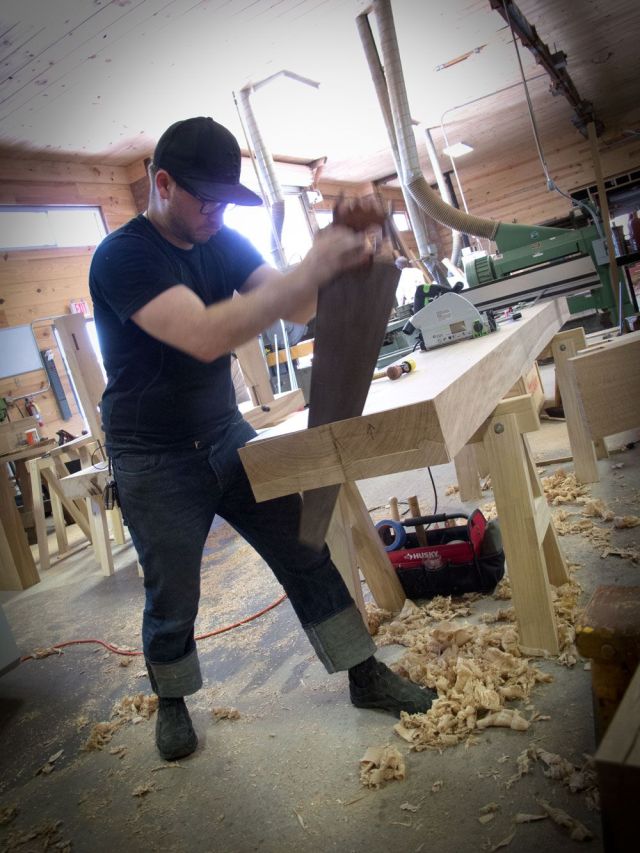 Author’s Note: This is the third of a three-part interview with Chris about The Anarchist’s Tool Chest. If you missed the first two conversation, you can read them here and here. As promised, this final installment was generated entirely by reader questions. A special thank you to all of you who sent in questions for Chris, including the many thoughtful queries that I was unable to work into this interview.
Author’s Note: This is the third of a three-part interview with Chris about The Anarchist’s Tool Chest. If you missed the first two conversation, you can read them here and here. As promised, this final installment was generated entirely by reader questions. A special thank you to all of you who sent in questions for Chris, including the many thoughtful queries that I was unable to work into this interview.
— Brian Clites, your forum moderator and author of thewoodprof.com.
brian@lostartpress.com
Jeff: Chris, in The ATC you captured my attention because you interwove your heartfelt conviction about the state of modern consumerism into a book about traditional woodworking. Do you have other convictions that can likewise linked to how or why you’re in the craft? If so, any plans for a book along those lines?
Christopher Schwarz: Aesthetic anarchism is pretty much the framework for my approach to the craft and life. It even guides the way I buy music and food.
I have lots of other things I feel strongly about, but they don’t have much to do with the craft directly. For example, I don’t believe in free will (it’s a long explanation and not a religious one), but I probably shouldn’t write a woodworking book titled: “You were Supposed to Screw That Up.” I will have to give this some more thought, however. It’s a tough question.
Leslie: Chris, I’ve come to regard your time-honored design for an English sawbench as essential in my shop. But I have difficulty keeping the saw in alignment, especially when using postures that aren’t unduly tiring on my body. I’ve tried the posture you describe in The Anarchist’s Tool Chest [pp. 285 – 286], but had little luck. Could you please explain one or two alternative (but still efficient) body stances for using the sawbench?
CS: The only other body stances I know for sawbenches involve sitting down to rip (a la French) or some of Adam Cherubini’s odd foot stylings he showed in his Arts & Mysteries columns.
If the traditional stance doesn’t work, you might try overhand ripping at the bench. That works for most (and is what I prefer, actually)For crosscutting, try clamping the work to the sawbenches and see if you can employ one leg comfortably to stabilize the work.
Turning the saw around so the teeth face away from you is another solution, as in this photograph:

You’d have to have the work secured with clamps or perhaps one leg. It also spreads out the work between both arms, which helps some people. I am sure there are other stances out there. I just haven’t encountered them. Apologies.
Jacob: Hi Chris. My question is about the relationship between construction methods and philosophy. In The Anarchist’s Tool Chest, I thought you were arguing that the dovetail – because of its history in the craft, the skill it demonstrates, the tradition it represents – is emblematic of woodworking anarchy. Yet you’ve recently done away with this joinery in the “baby” ATC, and the only dovetails I’ve noticed in the posts about your forthcoming Furniture of Necessity are the sliding dados on the table.
Just so you understand where I’m coming from, last year I didn’t feel confident had cutting dovetails, so I actually had to make my ATC with rabbets and screws. But that gets to the heart of my question: What is the anarchist’s joint? Does the concept of a beginner’s chest supplant any of your arguments in The Anarchist’s Tool Chest? I guess I’m wondering if woodworking anarchy is more of a skill set or a mindset? Thank you.
CS: For me what is important is that the joinery be superior to the crap that falls apart in a few years. Nails and screws that have been thoughtfully driven can last 200 or 300 years.
It also relates to the material. Dovetailing melamine will probably end poorly.
So while I love the dovetail and think it is the end-all joint, screws and nails and other well-made joints in solid material can outlast us all. Whatever joint it is, make it well and use good materials – that’s the opposite of the typical factor-made thing.
Cameron: The Anarchist’s Tool Chest is a book that had a big impact on my making philosophy. Not only because it turned me on to hand tool woodworking, but because aesthetic anarchism as it was presented tied up a lot of the ideas that brought me to the craft in the first place. It was one of those great moments when you’re reminded there are people out there who feel the same way about something, and not only that, but here’s someone who is doing it in a way that can have a real impact on our culture. OK, fanboy bit finished. Now for my question:
As someone who works in the technology sector, I’m interested to know: Have you ever come across a furniture maker who exemplifies aesthetic anarchism while using automated technology? I can imagine a future where tools like Cad, Makerbot, CNC, and 3D printing – programed to produce traditional pieces with traditional joinery – could allow individuals to make more of their own goods, and probably in a smaller home workshop than we currently need.
CS: Tools are neutral. My table saw grants me freedom by feeding my family at times. When I worked in a factory shop, the table saw was a symbol of my submission.
What is important to me is that people make things instead of buying them (if possible). So CAD, 3D printing, laser-cutting, water-jet machines and Shopbots are all awesome ways to accomplish that goal.
But why do I like hand tools so much and encourage others to try them? Everything with a cord ends up n the landfill. Hand tools last centuries. Sustainability is important to me.
Hand tools have fewer limits than machines (think chisel vs. table saw). A table saw limits your cut with a table, a fence, the size of the rails and the diameter of the blade. A chisel has almost no limits when it comes to shaping wood.
But I try not be a jerk about it. If you make stuff, you’re cool in my book.
Brian: Following up on Cameron’s vision: Chris, ever the twain shall meet? Is craft anarchism essentially about the ends of furniture quality and maker independence? Or the means through which that furniture is made?
CS: It’s both. If you don’t make it, then you can’t have an end product. If you don’t have an end product, then you aren’t making anything.
I know it seems circular. It probably is. Maybe I should write a book on turning.
Stupidity aside: The ways and the means are equally important. You can’t have handmade objects without someone making them.
Brian: Or can you?…
Ethan (The Kilted Woodworker): Chris, can you confirm the rumor that all involved with the writing, editing, and publishing of The Anarchist’s Tool Chest have a secret tattoo hidden somewhere on their body?
CS: I’m 47. I was born in an era where only criminals and sailors had tattoos. And I don’t like needles. Plus, even if I had a tattoo, you’d never be able to find it beneath my fine layer of yeti fur.
